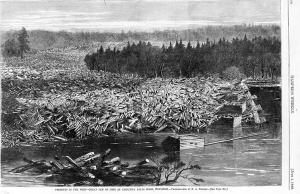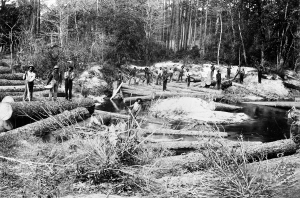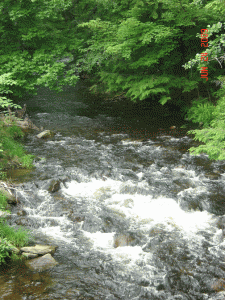



Freshets were necessary to float the rafts of lumber to market, but they could cause much devastation.
May Flood 1832
“During the winter, large quantities of lumber from the Halfway Brook mills were drawn to Barryville, made into rafts, then taken to Handsome Eddy, two or three miles further down the river. There they waited for the spring freshets…
“In early spring 1832, at least 2,000,000 feet, and 20 to 25 double rafts of sawn lumber sat at Handsome Eddy, ready to float to market. The water level of the river remained low through the first week of May, which was unusual.
“Owners were anxious to get their rafts to market; the raftmen were uneasy about doing so in such low water. What to do?
“Starting May 8, 1832, it rained violently day and night for three days and nights. The Delaware River, a raging flood, was covered with the valuable lumber and rafts which had been anchored in Handsome Eddy…
“The May flood, was the highest known until the flood of 1869 and one in 1895, which was 16 inches higher.”—Johnston’s Reminiscences, p. 276.
Freshet Damage in 1846
In Phoebe Maria Eldred Austin’s 1846 letter to her sister Mary Ann Eldred, she mentioned the freshet damage done in Halfway Brook, that year.
Lumberland, July 13, 1846
Dear Sister,
I have delayed writing longer than I intended, but these lines will inform that we are well at present and I hope they will find you the same.
There’s been a freshet in the Halfway Brook. It has done much damage. There is not a bridge or dam left between here and Barryville. It has damaged us more than fifty dollars…From your affectionate sister, P. M. Austin







